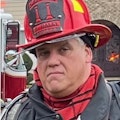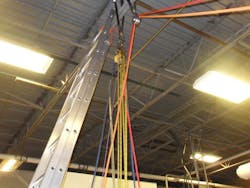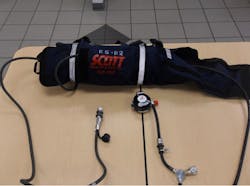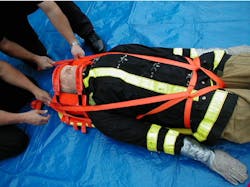Training Doesn't Have Time for Rain Delays
Preparation is a key to a successful training outcome. From development, media review, scheduling, staffing, equipment procurement and performance standards, the course material has to be drafted and set into motion well before the actual event. But what happens when the day comes for the training and the elements outside are less than ideal? Members arrive and expect instruction to take place, whether it is a monthly department drill or annual topics for review. Either way, it is up to the training division to be prepared for when the weather keeps the learning opportunities indoors.
Fire stations have a few key attributes for successful training. Apparatus areas are usually vast in size and can have different elevations within the space for storage rooms and equipment areas. Large floor areas allow for enough room for all attendees to be able to perform the skills of the lesson, and comfort areas for rest and rehabilitation are usually directly off the training area. Furthermore, the lecture portion of the training can be completed in the training room and the students can move directly to the apparatus bay floor to practice what they had just learned.
So when the weather (rain, snow, cold, high winds, etc.) limits the training arena to the indoors, consider some quality hands-on training drills that can be completed within the walls of the station with a minimal amount of equipment.
Indoor training ideas
Ventilation—Most departments practice ventilation by forcing/breaking windows or opening up roofs on structures. While these skills are critical, a key point to ventilation is the control of the air or flow path. It is vital to understand that once the building is opened up, controlling the air flow is still a function of the vent crew. This can be demonstrated with ventilation fans, tarps or salvage covers, and theatrical smoke. Crews hang tarps or covers over existing doorways into the apparatus bay area, and place a fan by each door. If theatrical smoke generation is available, fill the area with smoke, and start to open up covered doors for natural ventilation. Next, choose one door and turn on the fan; position the fan so that it will force air into the area, and then position the fan so it forces air out of the area (Venturi effect). Further effects can be demonstrated by limiting the size of the opening for ventilation through door control or physical means.
Rope/rescue operations—One of the most underestimated tools on the fireground is a length of rope. Every department carries rope, but most firefighters shy away from using it, mostly due to lack of practice of basic knots used on the incident scene. A good refresher drill starts by laying out a variety of tools from the apparatus on the apparatus floor area and laying out a few pieces of utility rope by the tools. Members can take turns moving from tool to tool, tying an appropriate knot that can be used to hoist the tool up to an above-grade area. The focus here should be on attaching the rope to the item so it does not come loose and fall out of the attachment.
Lifting and moving objects—Fundamental skills for moving heavy objects are critical on the rescue scene. Staff vehicles and trailers can serve as objects for lifting and moving. This drill can cover all aspects of lifting equipment on the apparatus, including pneumatic air bags, manual hydraulic jacks, manual jacks, hydraulic tools, cribbing, struts and levers. Be sure to clear a large area of the apparatus bay floor for this training, as skills involving this operation can require a significant amount of space to operate in. A heightened level of safety and awareness shall be prevalent any time powered tools are in operation and heavy objects begin to leave the ground.
Patient packaging—Most members are competent in securing victims within the packaging devices that they have at their disposal. What happens when the call comes that will not allow the department to use the devices that the members are familiar with? Perhaps the victim does not fit into the device, the area the victim is in is not large enough to allow the device to be deployed, or the injuries to the victim will not allow them to be packaged in any other position than the one they are presently in. Do your members have the skills to safely and efficiently improvise their skills to remove a victim in this case? While the functions of the packaging devices are critical, accessibility to the victim with the device is first and foremost (see Photo 5). Limiting the area for packaging is one way to improve the efficiency of the member’s skills, along with providing a scenario that requires the member to improvise their removal. Planning ahead for these incidents will pay dividends in the long run.Conclusion
Sometimes the best efforts in planning company training are derailed by situations beyond our control. Inclement weather hampers the learning environment by putting undue stress and discomfort on the student, and takes the momentum from the learning environment. The previous mentioned drills just scratch the surface of the potential for indoor training within your respective department. With a little creativity and some preparation, training officers can be ready for any type of training topic, whether the classroom is indoors or outdoors. All that is needed is a little resourcefulness.
Until next time, stay focused and stay safe.
MICHAEL DALEY, a Firehouse.com Contributing Editor, serves with Monroe Township, NJ, Fire District No. 3 as a lieutenant and serves on New Jersey Task Force 1. He earned the Master Fire Instructor certification from the ISFSI and is an instructor at the Middlesex County Fire Academy where he developed rescue training curriculum. He is a managing member of Fire Service Performance Concepts.
About the Author

Michael Daley
MICHAEL DALEY, who is a Firehouse contributing editor, recently retired as a 37-year veteran who served as a captain and department training officer in Monroe Township, NJ. He is a staff instructor at multiple New Jersey fire academies and is an adjunct professor in the Fire Science Program at Middlesex County College. Daley is a nationally known instructor who has presented at multiple conferences, including Firehouse Expo and Firehouse World. His education includes accreditations as a Chief Training Officer and a Fire Investigator, and he completed the Craftsman Level of education with Project Kill the Flashover. Daley is a member of the Institution of Fire Engineers and a FEMA Instructor and Rescue Officer with NJ Urban Search and Rescue Task Force 1. He operates Fire Service Performance Concepts, which is a training and research firm that delivers and develops training courses in many fire service competencies.





